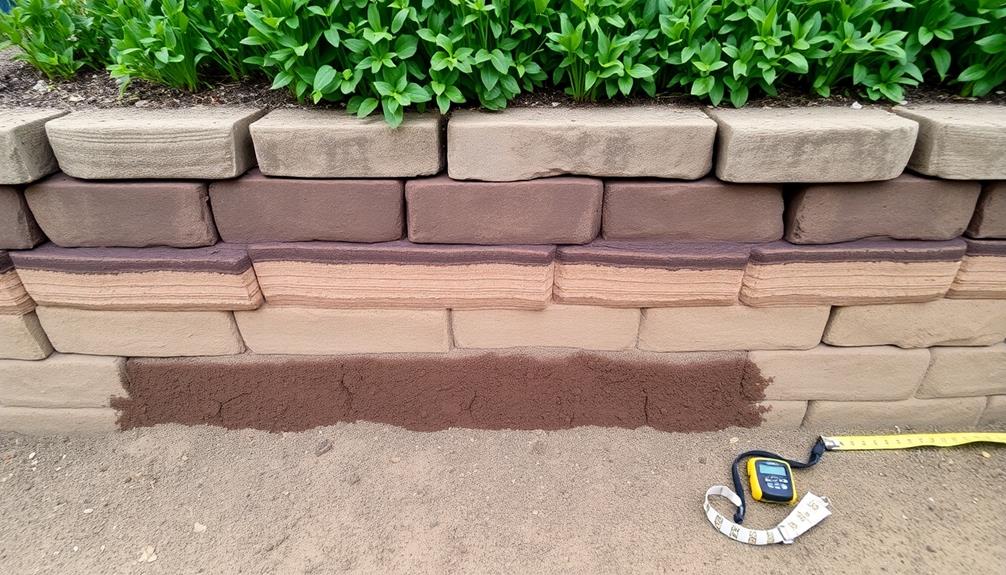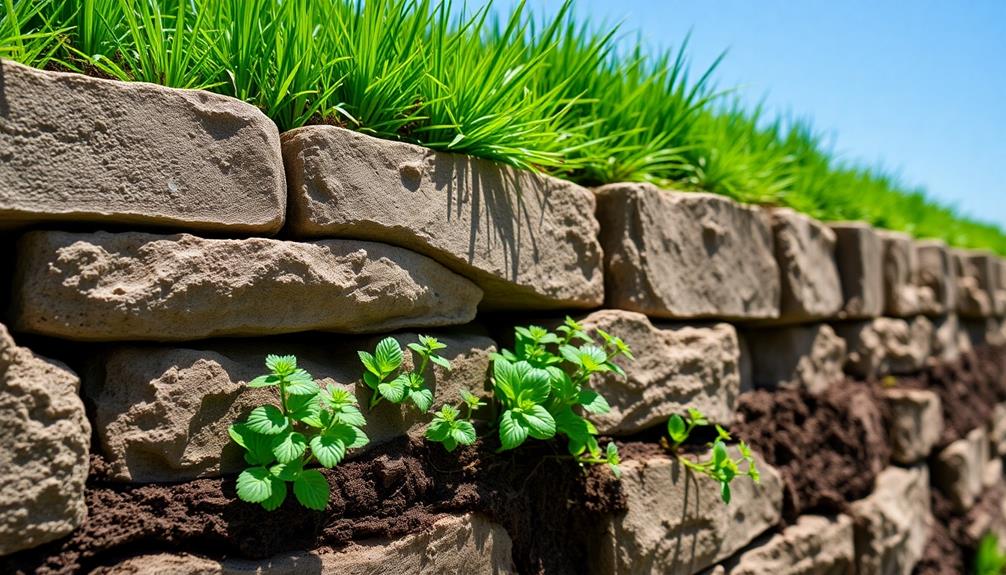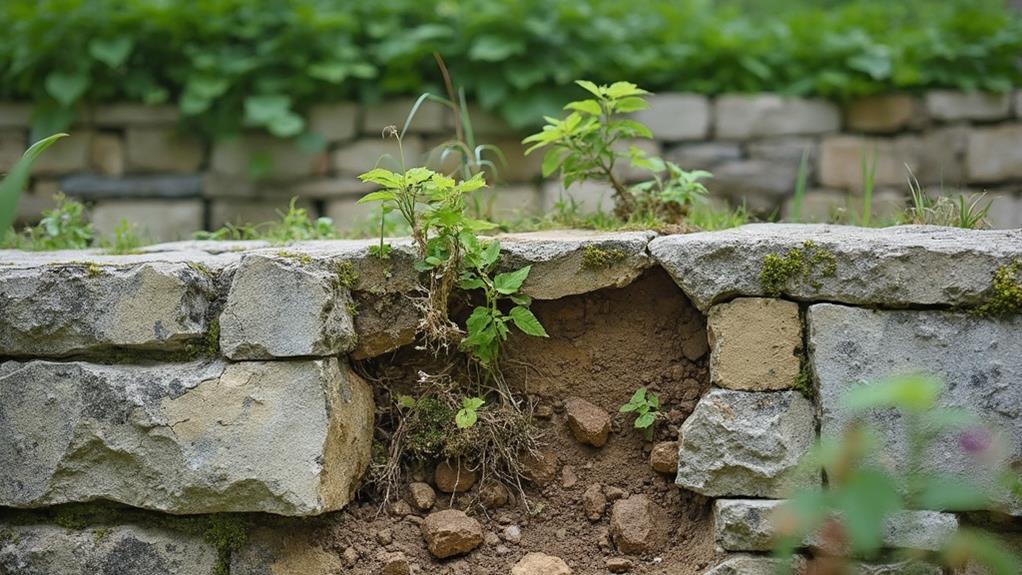Regular maintenance of retaining walls is essential for preserving structural integrity, safeguarding safety, and protecting property value. Through consistent upkeep, property owners can identify early signs of deterioration, evaluate load-bearing capacity, and assess material condition. Proper maintenance prevents hydrostatic pressure buildup, extends the wall's lifespan, and maintains aesthetic appeal by preventing unsightly growth and stains. Additionally, well-maintained retaining walls enhance overall property worth, demonstrate responsible management, and guarantee compliance with local regulations. By implementing a proactive approach to address minor issues and employing effective waterproofing techniques, property owners can achieve long-term cost savings and preserve their investment. The following sections explore these benefits in greater detail.
Table of Contents
ToggleWalls Contractor Highlights
- Regular maintenance ensures structural integrity, preventing early signs of compromise or deterioration.
- Proper upkeep maintains aesthetic appeal, preventing unsightly stains and enhancing property value.
- Consistent maintenance prolongs the wall's lifespan, saving costs and preventing premature deterioration.
- Routine inspections identify and address minor issues before they become major problems.
- Regular maintenance ensures compliance with local building codes, avoiding potential legal issues and fines.
Structural Integrity Assessment Procedure

Conducting a thorough structural integrity assessment of retaining walls is vital for preserving their long-term stability and safety. These walls are particularly important because they battle gravity to prevent erosion and create usable spaces.
This process encompasses a range of methodologies, including visual inspection techniques to identify surface-level issues, load-bearing capacity testing to evaluate the wall's ability to withstand pressure, and material deterioration analysis to assess the condition of the wall's components. By methodically implementing these assessment procedures, engineers and maintenance professionals can accurately gauge the overall health of the retaining wall structure, identify potential weaknesses, and develop targeted maintenance strategies to sustain its continued functionality and durability.
Visual Inspection Techniques
A keen eye forms the foundation of effective retaining wall maintenance. Visual inspection techniques, when applied systematically, can reveal early signs of structural compromise or deterioration. These techniques involve a meticulous examination of the wall's surface, joints, and surrounding soil conditions. Skilled inspectors employ a range of observational methods to identify potential issues before they escalate into costly repairs.
To conduct a thorough visual inspection, professionals typically follow these key steps:
- Assess the wall's overall alignment, looking for bulges, leaning, or displacement
- Examine the surface for cracks, spalling, or efflorescence, which may indicate water infiltration or material degradation
- Inspect drainage systems, including weep holes and lateral drains, ensuring proper water management
Load-Bearing Capacity Testing
While visual inspections provide valuable insights, a thorough evaluation of a retaining wall's structural integrity requires more advanced testing methods. Load-bearing capacity testing, a vital component of structural integrity assessment, involves sophisticated techniques to determine the wall's ability to withstand anticipated loads and pressures. This process typically encompasses a series of non-destructive tests, including core sampling, penetration resistance measurements, and load simulation exercises.
Engineers employ specialized equipment, such as hydraulic jacks and pressure sensors, to apply controlled forces to specific points along the retaining wall. These tests simulate various load scenarios, allowing experts to evaluate the wall's response to different stress levels. Additionally, geotechnical investigations of the surrounding soil provide valuable data on foundation stability and potential settlement issues.
The results of these comprehensive tests are meticulously analyzed to determine the wall's current load-bearing capacity and identify any areas of concern. This information enables property owners and maintenance teams to make informed decisions regarding necessary repairs, reinforcements, or potential redesigns to maintain the continued safety and longevity of the retaining wall structure.
Material Deterioration Analysis
Evaluating material degradation constitutes a crucial part of the structural integrity assessment procedure for retaining walls. This analysis involves a thorough examination of the wall's components to identify signs of wear, corrosion, or structural compromise. Engineers employ various techniques to assess the condition of materials, including visual inspections, non-destructive testing, and laboratory analysis of samples.
The material deterioration analysis typically encompasses:
- Assessment of concrete integrity, including identification of cracks, spalling, and reinforcement corrosion
- Evaluation of soil conditions and their impact on the wall's stability
- Examination of drainage systems to safeguard proper water management and prevent hydrostatic pressure buildup
Benefits

Regular maintenance of retaining walls offers numerous advantages that extend beyond mere upkeep. Properly maintained retaining walls can safeguard against erosion on your property, directing rainwater away from your home, which protects the landscape and foundation.
Additionally, the benefits encompass enhanced structural integrity, improved aesthetic appeal, increased property value, and a prolonged wall lifespan, all of which contribute to the overall functionality and desirability of the property. By investing in consistent maintenance practices, property owners can guarantee their retaining walls remain robust, visually pleasing, and valuable assets for years to come.
Enhanced Structural Integrity
One of the primary benefits of regular maintenance for retaining walls is enhanced structural integrity. By consistently inspecting and addressing potential issues, property owners can significantly extend the lifespan of their retaining walls while ensuring ideal performance. This proactive approach not only safeguards the stability of the surrounding landscape but also protects the investment made in the wall's construction.
Regular maintenance contributes to enhanced structural integrity through:
- Early detection of soil erosion or settlement behind the wall, allowing for timely remediation
- Identification and repair of cracks, bulges, or other signs of structural stress before they escalate
- Preservation of drainage systems, preventing water buildup that can compromise the wall's stability
As members of a community that values responsible property management, we comprehend the importance of maintaining our retaining walls. By adhering to a regular maintenance schedule, we not only protect our individual investments but also contribute to the overall safety and aesthetic appeal of our neighborhoods. Properly maintained retaining walls resist the forces of nature more effectively, providing long-term stability and peace of mind for property owners and the community at large.
Improved Aesthetic Appeal
The aesthetic appeal of a retaining wall markedly improves with regular maintenance, contributing to the overall visual charm of a property. Well-maintained walls exude an air of sophistication and care, enhancing the curb appeal and potentially increasing the property's value. As members of a community, homeowners who prioritize the upkeep of their retaining walls demonstrate a commitment to neighborhood beautification and collective pride.
Regular cleaning and repair of retaining walls prevent the accumulation of unsightly stains, moss, and algae growth that can detract from their appearance. By addressing minor issues promptly, such as repainting faded surfaces or replacing damaged blocks, property owners guarantee that their walls remain visually pleasing and structurally sound. Additionally, proper maintenance allows for the integration of landscaping elements, such as climbing plants or decorative lighting, which can transform a utilitarian structure into an attractive focal point. This harmonious blend of form and function not only satisfies individual aesthetic preferences but also contributes to the overall visual cohesion of the surrounding environment, fostering a sense of belonging and shared appreciation for well-maintained outdoor spaces.
Increased Property Value
Beyond enhancing aesthetic appeal, well-maintained retaining walls can markedly boost property value. These structures not only serve a functional purpose but also contribute significantly to the overall worth of a property. Real estate professionals and appraisers often consider the condition of retaining walls when evaluating a property's value, recognizing their importance in land management and erosion control.
Homeowners who invest in regular maintenance of their retaining walls can expect to reap several financial benefits:
- Increased curb appeal, attracting potential buyers and commanding higher offers
- Prevention of costly structural damage to the property, preserving its long-term value
- Compliance with local building codes and regulations, avoiding potential legal issues and fines
Prolonged Wall Lifespan
Regular maintenance of retaining walls substantially extends their lifespan, resulting in long-term cost savings and improved structural integrity. By implementing a consistent maintenance routine, property owners can greatly prolong the functional life of their retaining walls, ensuring they continue to perform their essential role in soil retention and erosion control for many years to come. This proactive approach not only prevents premature deterioration but also addresses minor issues before they escalate into major structural problems.
Routine inspections and maintenance procedures, such as cleaning drainage systems, repairing cracks, and reinforcing weak points, contribute to the wall's longevity. These practices help maintain the wall's structural integrity by preventing water buildup, soil erosion, and other factors that can compromise its stability over time. Additionally, regular upkeep allows for the early detection of potential issues, enabling timely interventions that can prevent costly repairs or complete wall replacement.
Waterproofing Techniques for Longevity

Effective waterproofing techniques are vital for ensuring the longevity of retaining walls, protecting them from moisture-related damage and structural instability. Proper membrane application methods, integration of efficient drainage systems, and careful selection of appropriate sealants form the cornerstone of a comprehensive waterproofing strategy. The following table outlines key considerations for each of these critical components in retaining wall waterproofing:
| Technique | Purpose | Key Considerations |
|---|---|---|
| Membrane Application | Creates a barrier against water intrusion | Proper surface preparation, even coverage |
| Drainage System | Directs water away from the wall | Adequate sizing, proper slope, filter fabric |
| Sealant Selection | Fills gaps and joints to prevent leaks | Compatibility with substrate, durability |
Membrane Application Methods
Waterproofing membranes play a necessary role in protecting retaining walls from moisture damage and extending their lifespan. The application of these protective barriers requires precision and expertise to guarantee optimal performance.
Several methods are employed by professionals to apply waterproofing membranes effectively:
- Liquid-applied membranes: Sprayed or rolled onto the surface, these versatile coatings form a seamless barrier against water infiltration.
- Sheet membranes: Pre-fabricated sheets are adhered to the wall surface, providing a uniform and durable waterproofing layer.
- Bentonite clay systems: Natural clay materials are applied to form a self-sealing barrier when exposed to moisture.
Each method has its advantages and is chosen based on factors such as wall composition, soil conditions, and climate. The application process typically involves thorough surface preparation, including cleaning and repairing any existing damage. Professionals then carefully apply the chosen membrane, ensuring complete coverage and proper sealing at joints and penetrations.
Regular inspections and maintenance of these waterproofing systems are essential to identify and address any potential issues before they compromise the wall's integrity, ultimately safeguarding your property and investment.
Drainage System Integration
While waterproofing membranes provide a critical barrier against moisture intrusion, integrating a proper drainage system enhances the longevity of retaining walls. This thorough approach guarantees that water is not only prevented from penetrating the structure but is also efficiently directed away from its foundation.
A well-designed drainage system typically incorporates perforated pipes, gravel backfill, and strategically placed weep holes to channel water away from the retaining wall.
The integration process begins with the installation of a drainage pipe at the base of the wall, surrounded by a layer of permeable material such as gravel. This allows water to flow freely towards the pipe, which then directs it away from the structure. Weep holes are incorporated at regular intervals along the wall's face, providing additional pathways for water to escape.
The combination of these elements works synergistically with the waterproofing membrane to create a robust defense against hydrostatic pressure and soil erosion. By implementing this integrated approach, property owners can vastly extend the lifespan of their retaining walls, minimize maintenance costs, and guarantee the structural integrity of their investment for years to come.
Sealant Selection Considerations
For retaining walls to withstand the test of time, selecting the appropriate sealant is essential. The choice of sealant plays a pivotal role in protecting the structure from moisture intrusion, which can lead to deterioration and compromise the wall's integrity.
When considering sealant options, property owners and maintenance professionals should focus on products specifically designed for retaining wall applications, taking into account factors such as climate, soil composition, and expected water exposure.
To guarantee optimal performance and longevity of your retaining wall, consider the following key factors when selecting a sealant:
- Flexibility and elasticity to accommodate structural movement
- UV resistance to prevent degradation from sun exposure
- Chemical resistance to withstand soil contaminants and fertilizers
High-quality polyurethane or silicone-based sealants are often preferred for their durability and ability to maintain their protective properties over extended periods. These sealants form a robust barrier against water infiltration, helping to preserve the structural integrity of the retaining wall and prevent costly repairs.
Regular inspection and reapplication of sealants as part of a comprehensive maintenance program will substantially extend the lifespan of your retaining wall, ensuring its continued functionality and aesthetic appeal for years to come.
Walls Contractor FAQ
How Often Should I Inspect My Retaining Wall?
To guarantee the safety and longevity of your retaining wall, it's recommended to inspect it at least twice a year, typically in spring and fall. Additionally, conduct checks after severe weather events or if you notice any changes in the structure.
Can I Perform Maintenance on My Retaining Wall Myself?
Yes, you can perform some basic maintenance on your retaining wall yourself. However, for more complex issues or structural concerns, it's advisable to consult a professional to guarantee the wall's integrity and your safety.
What Are Signs That My Retaining Wall Needs Immediate Attention?
Signs your retaining wall needs immediate attention include visible cracks, bulging or leaning, water seepage, soil erosion behind the wall, and separation from adjoining structures. Regular inspections help us catch these issues early, ensuring our property's safety and longevity.
How Much Does Professional Retaining Wall Maintenance Typically Cost?
Professional retaining wall maintenance costs typically range from $500 to $3,000, depending on wall size, material, and required repairs. Regular inspections and minor upkeep can help us avoid more expensive repairs down the line, ensuring our property's long-term stability.
Are There Specific Maintenance Requirements for Different Types of Retaining Walls?
Yes, different retaining wall types have specific maintenance needs. Concrete walls may require sealing, timber walls need rot prevention, and stone walls often need repointing. Regular inspections and addressing drainage issues are pivotal for all types, ensuring longevity and safety.







